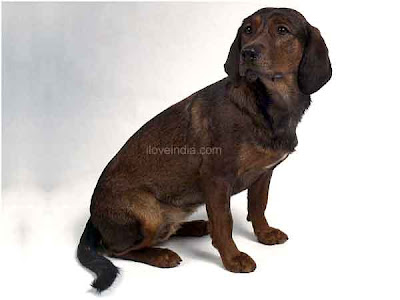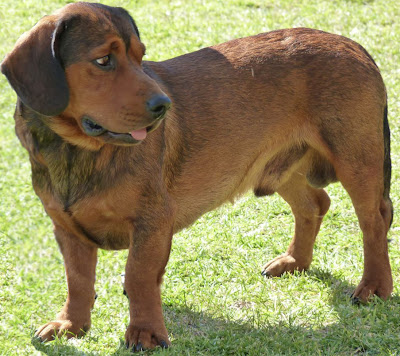 |
| Alpine Dachsbracke Height at withers34-42 cm. Ideal height for dogs : 37-38 cm. Ideal height for bitches : 36-37 cm. |
Behavior
This hardy, obstinate, agile dog has great stamina, a fighting spirit, a good voice and a very keen sense of smell. He does not hunt in packs. He is used in hunting hare, fox, and wild boar, retrieving feathered game (wild goose, ect.) and tracking wounded game. He makes a very affectionate pet. He needs firm training.
Many dogs, such as the American Water Spaniel, have had their natural hunting instincts suppressed or altered to suit human needs. Modern dog breeds show more variation in size, appearance, and behavior than any other domestic animal. Within the range of extremes, dogs generally share attributes with their wild ancestors, the wolves. Dogs are predators and scavengers, possessing sharp teeth and strong jaws for attacking, holding, and tearing their food. Although selective breeding has changed the appearance of many breeds, all dogs retain basic traits from their distant ancestors. Like many other predatory mammals, the dog has powerful muscles, fused wristbones, a cardiovascular system that supports both sprinting and endurance, and teeth for catching and tearing. Compared to the bone structure of the human foot, dogs technically walk on their toes.
Sight: Like most mammals, dogs are dichromats and have color vision equivalent to red-green color blindness in humans. Different breeds of dogs have different eye shapes and dimensions, and they also have different retina configurations. Dogs with long noses have a "visual streak" which runs across the width of the retina and gives them a very wide field of excellent vision, while those with short noses have an "area centralis" a central patch with up to three times the density of nerve endings as the visual streak giving them detailed sight much more like a human's. Some breeds, particularly the sighthounds, have a field of vision up to 270° (compared to 180° for humans), although broad-headed breeds with short noses have a much narrower field of vision, as low as 180°.
Hearing: Alpine Dachsbracke Dog detect sounds as low as the 16 to 20 Hz frequency range (compared to 20 to 70 Hz for humans) and above 45 kHz (compared to 13 to 20 kHz for humans), and in addition have a degree of ear mobility that helps them to rapidly pinpoint the exact location of a sound. Eighteen or more muscles can tilt, rotate and raise or lower a dog's ear. Additionally, a dog can identify a sound's location much faster than a human can, as well as hear sounds up to four times the distance that humans are able to. Those with more natural ear shapes, like those of wild canids like the fox, generally hear better than those with the floppier ears of many domesticated species.
Smell: Scent hounds, especially the Bloodhound, are iconic for their keen sense of smell. Dogs have nearly 220 million smell-sensitive cells over an area about the size of a pocket handkerchief (compared to 5 million over an area the size of a postage stamp for humans). Some breeds have been selectively bred for excellence in detecting scents, even compared to their canine brethren. What information a dog actually detects when he is scenting is not perfectly understood; although once a matter of debate, it now seems to be well established that dogs can distinguish two different types of scents when trailing, an air scent from some person or thing that has recently passed by, as well as a ground scent that remains detectable for a much longer period. The characteristics and behavior of these two types of scent trail would seem, after some thought, to be quite different, the air scent being intermittent but perhaps less obscured by competing scents, whereas the ground scent would be relatively permanent with respect to careful and repetitive search by the dog, but would seem tobe much more contaminated with other scents. In any event, it is established by those who train tracking dogs that it is impossible to teach the Alpine Dachsbracke how to track any better than it does naturally; the object instead is to motivate it properly, and teach it to maintain focus on a single track and ignore any others that might otherwise seem of greater interest to an untrained dog. An intensive search for a scent, for instance searching a ship for contraband, can actually be very fatiguing for a Alpine Dachsbracke, and the dog must be motivated to continue this hard work for a long period of time.
The meaning of "intelligence" in general, not only in reference to dogs, is hard to define. Some tests measure problem-solving abilities and others test the ability to learn in comparison to others of the same age. Defining it for dogs is just as difficult. It is likely that dogs do not have the ability to premeditate an action to solve a problem.
Sprint Metabolism: Alpine Dachsbrackes can generate large amounts of energy for a short period of time. A dog's heart and lungs are oversized relative to its body and its normal everyday needs. A dog also has relatively more red blood cells than a human. Most of the time the dog will keep the extra red blood cells stored in its spleen. When the animal enters into a situation where its full metabolism is required, such as play, catching game, or fighting other dogs, the extra cells are released into the bloodstream. The "oversized" heart and lungs will now be running at full capacity, and the animal will have an enhanced ability to engage in aerobic activity. This activity will produce internal heating. Dogs, being covered in fur, are limited in their ability to cool down. After a short time the animal must either cease its athletic activity or risk harming itself from overheating. One can easily observe this pattern of intense activity followed by rest periods in puppies. During the rest phase the spleen collects red blood cells and the animal may pant to cool down.
Behavior and Intelligence: Many Alpine Dachsbrackes can be trained to skillfully perform tasks not natural to canines, such as in this dog agility competition. Alpine Dachsbrackes are valued for their intelligence. This intelligence is expressed differently with different breeds and individuals, however. For example, Border Collies are noted for their ability to learn commands, while other breeds may not be so motivated towards obedience, but instead show their cleverness in devising ways to steal food or escape from a yard. Being highly adaptable animals themselves, dogs have learned to do many jobs as required by humans over the generations.
Alpine Dachsbrackes are employed in various roles across the globe, proving invaluable assets in areas such as search-and-rescue; law enforcement (including attack dogs, sniffer dogs and tracking dogs); guards for livestock, people or property; herding; Arctic exploration sled-pullers; guiding the blind and acting as a pair of ears for the deaf; assisting with hunting, and a great many other roles which they may be trained to assume. Most dogs rarely have to deal with complex tasks and are unlikely to learn relatively complicated activities (such as opening doors) unaided. Some dogs (such as guide dogs for the visually impaired) are specially trained to recognize and avoid dangerous situations. For example, the ability to learn quickly could be a sign of intelligence. Conversely it could be interpreted as a sign of a desire to please. In contrast, some dogs who do not learn very quickly may have other talents. An example is breeds that are not particularly interested in pleasing their owners, such as Siberian Huskies. Huskies are often fascinated with the myriad of possibilities for escaping from yards, catching small animals, and often figuring out on their own numerous inventive ways of doing both.
Assistance Alpine Dachsbrackes are also required to be obedient at all times. This means they must learn a tremendous number of commands, understand how to act in a large variety of situations, and recognize threats to their human companion, some of which they might never before have encountered. Many owners of livestock guardian breeds believe that breeds like the Great Pyrenees or the Kuvasz are not easily trained because their stubborn nature prevents them from seeing the point of such commands as "sit" or "down". Hounds may also suffer from this type of ranking. These Alpine Dachsbrackes are bred to have more of a "pack" mentality with other dogs and less reliance on a master's direct commands. While they may not have the same kind of intelligence as a Border Collie, they were not bred to learn and obey commands quickly, but to think for themselves while trailing game.
A short legged, sturdy hunting dog with a robust, strong boned body structure, dense coat, firm muscles. Alpine Erzgebirgs Dachsbracke Temperament Expression intelligent and friendly. Fearless personality. Skull : Lightly arched. Well defined furrow in fore-head, lightly emphasized occiput. Jaws/Teeth : Strong complete teeth with scissor or pincer bite. A complete set with 42 teeth is sought after; the absence of totally two PM1 or PM2 (premolar 1 or 2) is tolerated; the M3 (molar 3) are not taken into account.
Eye : With dark brown iris. Eyelids close fitting to eyeballs with black pigment. Leathers : Set on high without folds, hanging broad and smooth, medium length (should reach to the canines), well rounded at tips. TAIL : Set on high, thick at root. Longer hair on underside (brush tail); reaching barely to ground, carried slightly downward. FOREQUARTERS : Front legs are straight and strong; they appear short in relation to the body. Shoulders : Shoulder blade close fitting, long, sloping and strongly muscled. HINDQUARTERS : Muscular, strong and well angulated. Seen from the rear, the axis of the legs is straight. FEET : Front and hind feet strong, round, toes tight against each other. Strong pads and black nails. HAIR : The double coat consists of very thick top coat and a dense undercoat, which covers the whole body and is close fitting. COLOUR : The ideal colour is dark deer red with or without black hairs lightly interspersed. Also black with clearly defined red-brown markings on head (Vieräugl), chest, legs, feet and underside of tail. White star on chest permitted.
FAULTS : Any departure from the foregoing points should be considered a fault and the seriousness with which the fault should be regarded should be in exact proportion to its degree and its effect upon the health and welfare of the dog.














0 comments:
Post a Comment